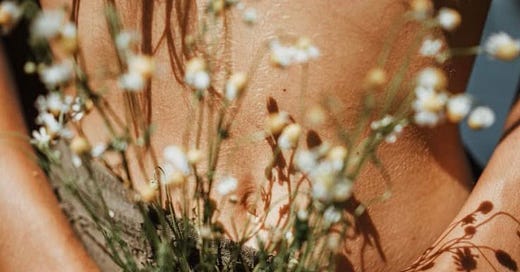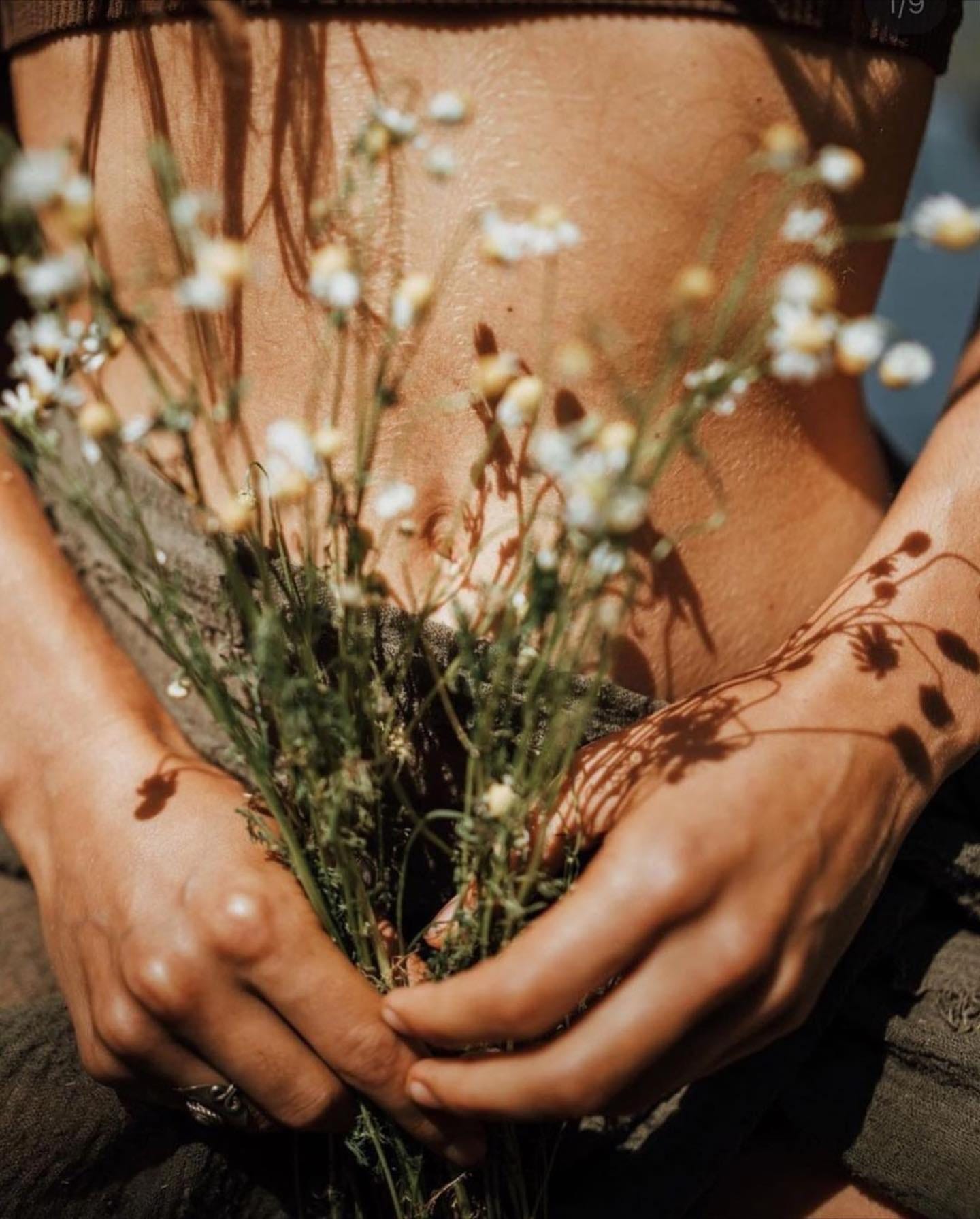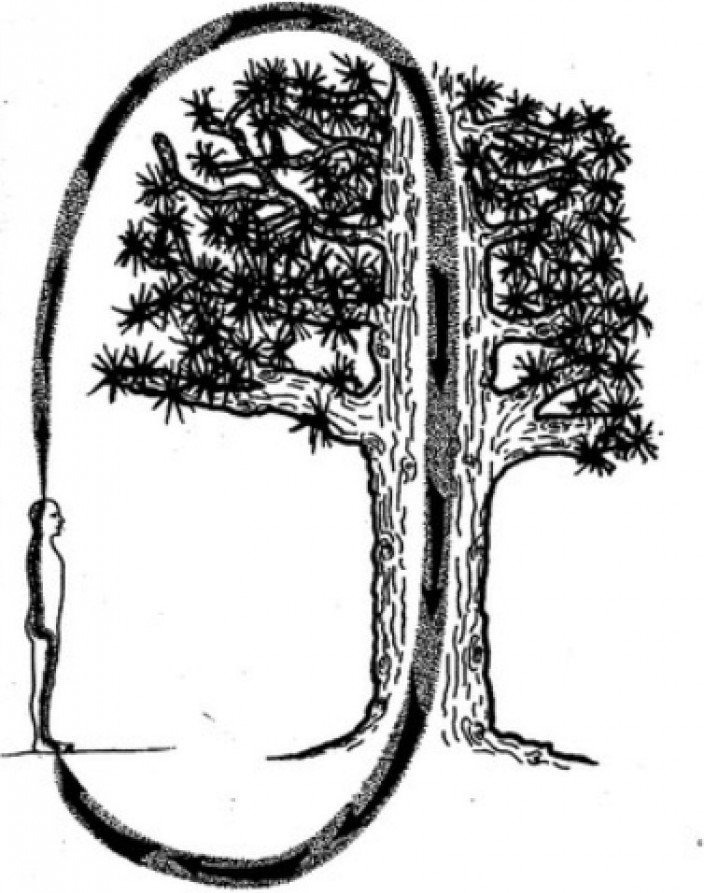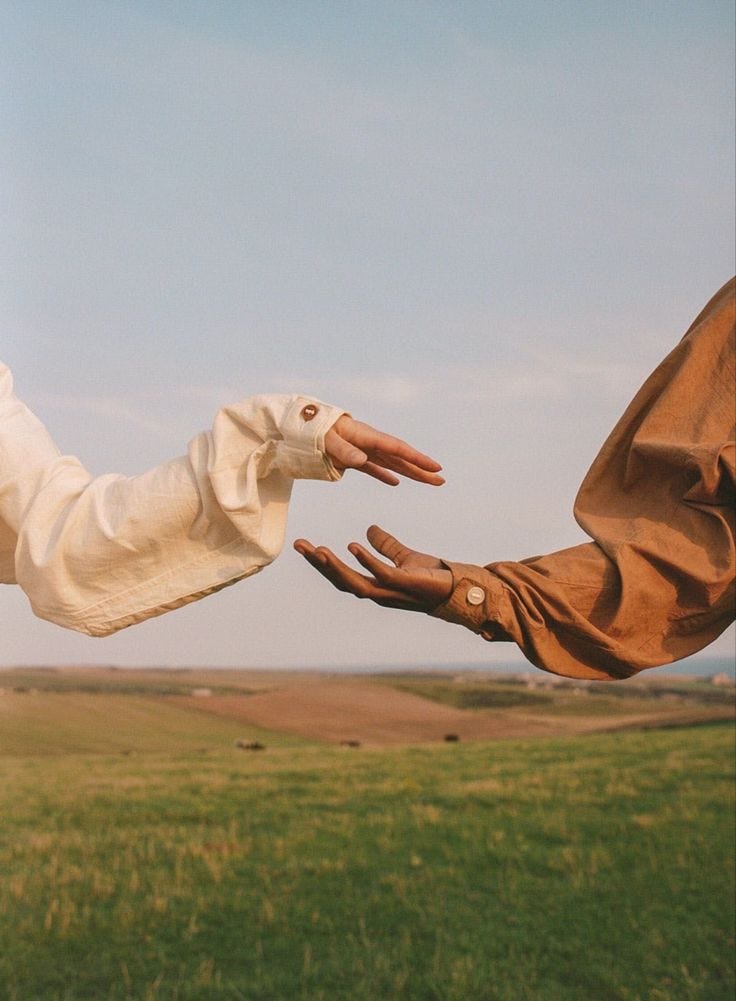Eco-Somatic Practices: Healing ourselves while healing the Earth
What if the Earth's wisdom lived in your body? In a disconnected world, eco-somatic practices reunite us with nature, where healing is reciprocal, and home is within and around us.
My journey began in pain—literal and metaphorical.
Endometriosis was my body's loudest cry, a landscape of inflammation and disconnection that medical interventions could never fully address.
I want to be clear: conventional medicine was not my enemy. In fact, medical technology provided my initial diagnosis, a crucial first step in understanding my body.
I started with pharmaceutical interventions that helped manage my pain, offering temporary relief, and for that, I am grateful. However, I began to notice that while they numbed the symptoms, they didn't address the root cause. The brain fog, the feeling of disconnection… these persisted.
For a long time, I treated my body like a battlefield, fighting against itself.
And for a while, I accepted it, because that's what we're taught: that pain is inevitable, that we must push through, that our bodies are problems to be managed rather than landscapes to be tended with care.
But true healing, I would learn, was not about fighting; it was about listening.
The body speaks
When I was diagnosed, I found myself asking a question that might seem strange to some: Why this disease? Is it trying to teach me something?
Maybe it seems wrong to think like that: to personify a condition, to seek meaning in suffering. But I felt like this was a question I needed to ask. Not to blame myself or the world, but to understand more deeply what was happening within me.
One of the answers I received was profound:
I was told that the womb is tied to our capacity to create, to bring forth life in all its forms, not just children, but ideas, visions, and purpose. My endometriosis, they suggested, might be reflecting a stagnation of creative energy that had nowhere to go.
When I heard this, I cried.
It resonated so deeply that it felt like a truth my body had been trying to tell me all along. I realized that the spark, the fire of creativity I had felt so strongly when I was younger, had been gradually muted and suppressed.
My wild ideas, my passionate visions, my desire to create change in the world… all of these had been slowly pushed aside by the demands of a life focused on productivity and conformity.
cute side note: This connection between creation and the womb is actually reflected in my project’s name "
", in Spanish it means "your print", a unique mark of identity. Our fingerprints are formed while we're in the womb, as our fingers press against the amniotic sac and womb walls (!!!). This gentle pressure creates the unique ridges and patterns that will identify us throughout our lives, all formed in that same sacred space of creation. Like fingerprints, our creative energy leaves a unique impression on the worldMy body was speaking.
The pain, the inflammation, the monthly struggle, all of it was a desperate language trying to communicate what my conscious mind had forgotten: that I was meant to create, to flow, to bring forth new life in whatever form it needed to take. (I am, again, crying as I write this down).
This realization became a turning point. Just as I was learning to listen to my body, I began noticing parallels in the world around me…
The Ecology of healing
Just like my body, the Earth is wounded, inflamed under the constant pressure of a culture of extraction and disconnection.
Every physical pain became a mirror: an internal ecosystem responding to the same forces that harm external ecosystems.
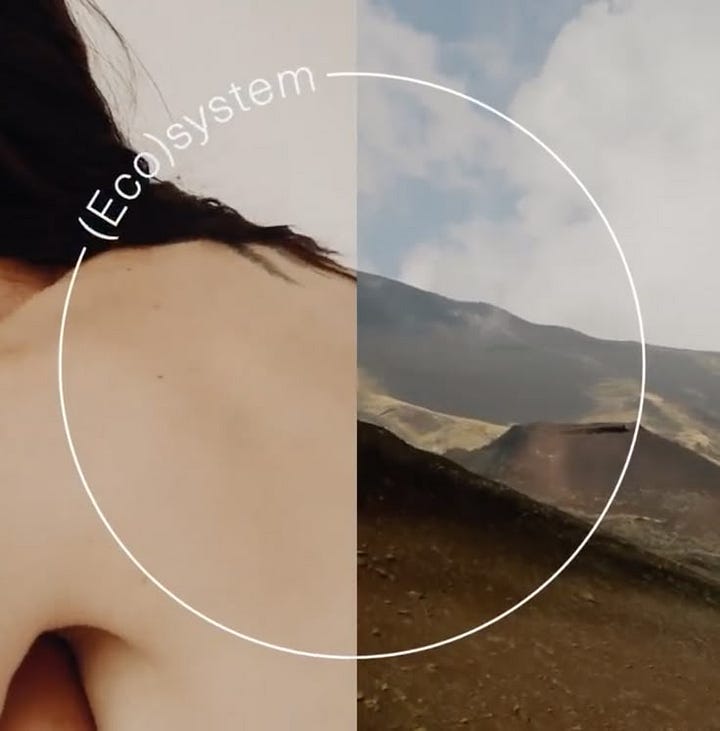

It is no coincidence that what is good for us is good for others and good for the Earth:
Consider consumer culture which pressures us to buy, upgrade, and discard… the same logic that depletes the soil, water, and forests also depletes us. The chronic stress of "keeping up" manifests in our bodies as inflammation. Microplastics in the ocean end up in our blood. The chemicals that disrupt ecosystems also disrupt our hormones…
I started listening to my body the way I had learned to listen to the Earth.
What if the pain wasn't just something to suppress but something to understand?
What if my body, like the land, held stories of depletion and imbalance;
and what if, like the land, it also held the wisdom to regenerate?
Healing became an act of radical listening.
I began to see my body as a living landscape, much like the ecosystems we seek to restore. Just as monoculture farming depletes soil, my previous approach had been extractive: demanding performance without regeneration.
I learned that healing is not about conquest, but about creating conditions for wholeness.
I discovered that hormonal balance is not unlike ecological balance, a delicate dance of interconnected systems. Every choice became an act of restoration:
reducing environmental toxins,
embracing cyclical rest,
listening to the subtle languages of my body.
This is where eco-somatic practices transformed everything: what nourishes us truly nourishes the planet; and what damages one damages the other.
Eco-Somatic Practices: Reclaiming the Body-Earth connection
Eco-somatics is an emerging field that bridges somatic practices (body-centered approaches to healing and awareness) with ecological understanding. It recognizes that our bodies are not separate from nature but are nature itself: microcosms of the same patterns, rhythms, and intelligence found in the living world.
At its core, eco-somatics challenges the mind-body dualism of Western thought and the human-nature separation that has led to exploitation of both our bodies and the Earth. It offers a framework for understanding how societal structures, environmental factors, and personal experiences are stored in our tissues and nervous systems.
Just as ecosystems fall out of balance due to extraction and depletion, our bodies suffer when we push them beyond their limits, disconnecting from their natural cycles.
Nervous System as Ecosystem
We often talk about ecology in terms of external systems; but what about our own bodies?
What if the exhaustion, the burnout, the chronic pain so many of us carry isn't just personal but systemic?
What if the way we've been taught to treat ourselves—ignoring the signs, prioritizing productivity over well-being, disconnecting from our natural cycles—is a mirror of the way we treat the Earth?
As eco-somatic practices weave together ecology, embodiment, and healing, they remind us that our bodies are living ecosystems, deeply intertwined with the world around us. They cultivate resilience, attunement, and reciprocity between our inner landscapes and the Earth's rhythms.
Some examples include:
Cyclical living:
Rather than forcing ourselves into a linear, high-performance mode every day, eco-somatic wisdom invites us to align our daily, monthly and seasonal rhythms with natural cycles (internal and external). Just as the Earth moves through cycles of growth, decay, and rest, our bodies do too. Learning when to push forward and when to slow down creates a rhythm within us.
Particularly for me, this meant tracking and syncing with my hormonal cycle, each of its four (yes four, not just the menstrual phase) phases.Nervous system rewilding:
Our nervous systems are wired for deep connection with the natural world, but modern life keeps us in a chronic state of stress and disconnection.Through conscious breathwork techniques (which became an anchor for me), slow movement, and sensory attunement, we can gradually rewild our nervous systems.
Earth-based rituals & embodied practices:
Connecting with the land can be a deeply somatic experience. Practices like barefoot grounding and bathing in natural bodies of water awaken our biological intelligence.
In Japan, Shinrin-yoku (forest bathing) is a well-documented practice that reduces cortisol levels, anxiety, and inflammation.
Another powerful practice in my healing journey was womb massage (also known as Arvigo therapy or traditional Maya abdominal therapy). This ancestral technique works directly with the creative center of the body. Using gentle, respectful touch, this practice helps restore proper positioning of the uterus, improve blood flow, and release stagnant energy.Regenerative rest:
Rest is an act of resistance (!), a radical declaration in a culture that glorifies busyness and equates productivity with worth. This is one of my favorite topics to discuss, because I've experienced firsthand how transformative intentional rest can be.
Just as overworked soil becomes depleted, unable to sustain life without periods of recovery, our bodies and nervous systems break down under constant demands.Regenerative rest isn't just about sleep (though quality sleep is essential). It's about creating spaciousness in our lives for the profound medicine of doing nothing. It's about allowing ourselves to exist without producing, to be rather than do.
Food & sensory nourishment:
When we eat seasonally, we sync our bodies with the Earth's natural rhythms: spring greens bring detoxifying properties just when our bodies need them after winter; summer fruits cool us with their high water content; fall root vegetables ground us as we prepare for winter's inward journey… Eating seasonally, slowing down to taste our food, and choosing nutrient-dense, plant-based meals connect us to the rhythms of the land.Creative expression:
Art-making is a profound eco-somatic practice that connects our creative energy with the Earth's generative force. We are naturally creative, just as the Earth is constantly creating, adapting, and transforming, yet many of us have learned to suppress this innate creativity or channel it only into productive, profit-generating endeavors.Creating, in whatever form, without judgment and specially without the expectation to monetize it, released the stagnant creative energy that had been affecting me.
Community engagement & collective healing:
Healing is not meant to happen in isolation. Spaces that honor the connection between body and Earth can become powerful containers of shared wisdom and mutual support, helping us process, restore, and grow together.I found that surrounding myself with people who understood this connection made all the difference—cultivating friendships that nourished me and relationships that replenished rather than depleted my energy.



A collaborative healing journey
My path to understanding wasn't solitary.
I reached out to a network of people, including my therapist, a nutritionist, herbalists, and traditional midwives. Each brought a piece of the puzzle. My background in regeneration principles became a bridge, helping me see my body as an ecosystem to be nurtured, not a machine to be fixed.
Herbal tinctures and adaptogens became powerful medicine in my healing journey. These weren't just supplements or alternative remedies; they were intelligent plant allies that spoke the language of my cells and helped my body remember its own capacity to heal.
If these plant allies were the medicine, then eco-somatic practices were the essential recalibration that created the conditions for healing, the foundation upon which the medicine could work effectively.
Shifting from extraction to regeneration, from suppression to deep listening. This is the same shift we need for planetary healing.
These practices are not about self-care in the commodified, surface-level sense. They are about rewilding our relationship with our own bodies, seeing ourselves as part of the web of life, not separate from it.
When I began aligning my life with these practices, everything changed. Today, I feel like a new person; I no longer see my body as something to fight against, but as an extension of the Earth itself. And I know that healing was never meant to be an isolated process—it's a communal, reciprocal act of restoration.
The same principles that heal ecosystems began to heal me:
꩜ diversity,
꩜ interconnection,
꩜ cyclical rhythms of rest and renewal…
My menstrual cycle, once a source of profound suffering, became a monthly report card of my overall systemic health.
Embodied activism: healing ourselves, healing the world
A note on accessibility: It's important to acknowledge that in our current capitalist system, these practices might seem like a luxury; another wellness trend accessible only to the privileged.
But this perception itself reveals a painful truth: what should be our birthright has been commodified and gatekept.
Our disconnection from these natural ways of being isn't accidental; it's the result of deliberate systemic forces that profit from our alienation from our bodies and the Earth.
The colonial, extractive mentality that has devastated ecosystems has simultaneously severed our connection to embodied wisdom. We're experiencing the effects of a system that benefits from our disconnection. The medical-industrial complex pathologizes our pain rather than recognizing it as communication.
The productivity cult tells us rest is laziness. Consumer culture sells us products to mask symptoms rather than address root causes.
The fact that reconnecting to our bodies feels "indulgent" or "impractical" is precisely the wound that needs healing. What could be more practical than inhabiting our own flesh? What could be more essential than remembering our place in the web of life?
This isn't about adding complexity to our lives. It's about reclaiming what has been taken from us.
It's about recognizing that our exhaustion, our disconnection, our chronic illness are not merely personal problems but political ones; symptoms of a world out of balance. And in this recognition lies revolutionary potential: the understanding that healing ourselves is an act of resistance against the very systems that would keep us separate, depleted, and dependent.
You don’t need a diagnosis to begin this journey. Eco-somatic practices are not reserved for those living with chronic illnesses. They are a way of being that belongs to all of us. Because healing is not only an individual process; healing is also a call to transform the structures that make us sick.
And this path is not just about relieving symptoms, but about deeply questioning the ways of living that harm us: the patterns of consumption, exploitation, and the normalized violence against all that is alive.
The way we heal is the way we lead.
If we are burned out, fragmented, and disconnected, our activism, our leadership, and our ability to create change will reflect that.
But when we root into practices that nourish us, we start leading from a place of wholeness.
We shift from sustainability—which often feels like barely holding things together—to regeneration, where we actively restore and replenish. Healing requires a fundamental reimagining of our relationship with ourselves and the living world.
I asked myself: What would your activism, your care for the world, look like if it also included that same radical and loving care for yourself?
This is not about a perfect healing narrative. It's about presence. About recognizing that every breath is an opportunity to realign, to remember, to restore. Our bodies are not machines to be optimized, but living ecosystems to be listened to, respected, and loved.
Returning to the body is returning to the Earth.
Listening to the body is listening to the natural world.
Healing ourselves is an act of resistance, of deep love, and of justice for all life.
And so, eco-somatic practices become an invitation:
To return home, to our body-earth,
To recognize that the health of one is the health of all,
To remember that personal and collective healing are not separate paths.
Today, I can say that my body keeps teaching me.
I’m still learning to inhabit it with tenderness, with patience, with curiosity. And I’m still learning to read, in my pain, in my pleasure, in my cycles, the signs that remind me of what needs to be tended to, cared for, and loved.

